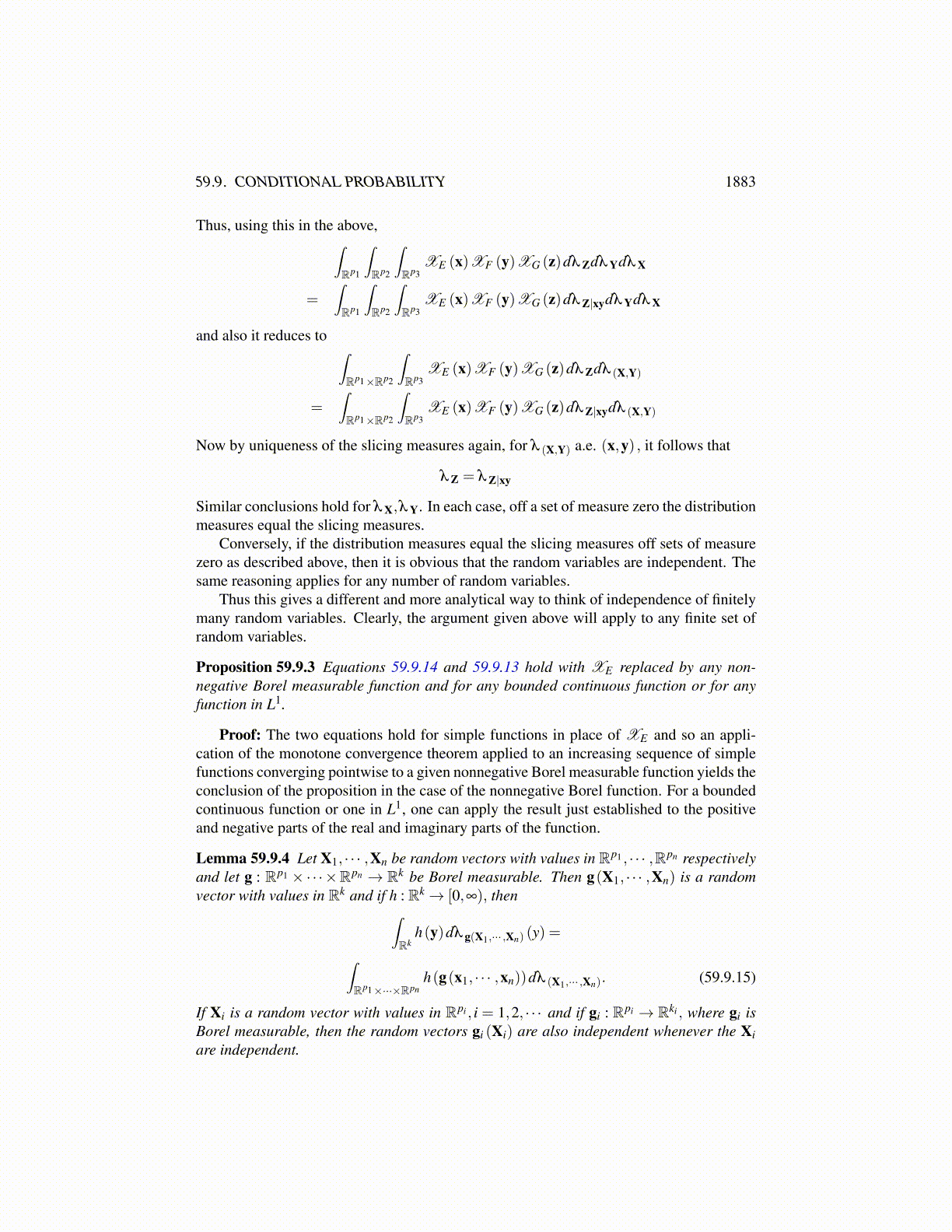
59.9. CONDITIONAL PROBABILITY 1883
Definition 59.8.5 For µ a probability measure on the Borel sets of Rn,
φ µ (t)≡∫Rn
eit·xdµ.
Theorem 59.8.6 Let µ and ν be probability measures on the Borel sets of Rp and supposeφ µ (t) = φ ν (t) . Then µ = ν .
Proof: The proof is identical to the above. Just replace λ X with µ and λ Y with ν .
59.9 Conditional ProbabilityHere I will consider the concept of conditional probability depending on the theory ofdifferentiation of general Radon measures. This leads to a different way of thinking aboutindependence.
If X,Y are two random vectors defined on a probability space having values in Rp1 andRp2 respectively, and if E is a Borel set in the appropriate space, then (X,Y) is a randomvector with values inRp1×Rp2 and λ (X,Y) (E×Rp2) = λ X (E), λ (X,Y) (Rp1 ×E) = λ Y (E).Thus, by Theorem 31.2.3 on Page 1085, there exist probability measures, denoted here byλ X|y and λ Y|x, such that whenever E is a Borel set in Rp1 ×Rp2 ,∫
Rp1×Rp2XEdλ (X,Y) =
∫Rp1
∫Rp2
XEdλ Y|xdλ X,
and ∫Rp1×Rp2
XEdλ (X,Y) =∫Rp2
∫Rp1
XEdλ X|ydλ Y.
Definition 59.9.1 Let X and Y be two random vectors defined on a probability space. Theconditional probability measure of Y given X is the measure λ Y|x in the above. Similarlythe conditional probability measure of X given Y is the measure λ X|y.
More generally, one can use the theory of slicing measures to consider any finite list ofrandom vectors, {Xi}, defined on a probability space with Xi ∈Rpi , and write the followingfor E a Borel set in ∏
ni=1Rpi .∫
Rp1×···×RpnXEdλ (X1,···,Xn)
=∫Rp1×···×Rpn−1
∫Rpn
XEdλ Xn|(x1,··· ,xn−1)dλ (X1,···,Xn−1)
=∫Rp1×···×Rpn−2
∫Rpn−1
∫Rpn
XEdλ Xn|(x1,··· ,xn−1)dλ Xn−1|(x1,··· ,xn−2)dλ (X1,···,Xn−2)
...∫Rp1· · ·∫Rpn
XEdλ Xn|(x1,··· ,xn−1)dλ Xn−1|(x1,··· ,xn−2) · · ·dλ X2|x1dλ X1 . (59.9.13)
Obviously, this could have been done in any order in the iterated integrals by simply modi-fying the “given” variables, those occurring after the symbol |, to be those which have beenintegrated in an outer level of the iterated integral. For simplicity, write
λ Xn|(x1,··· ,xn−1) = λ Xn|x1,··· ,xn−1